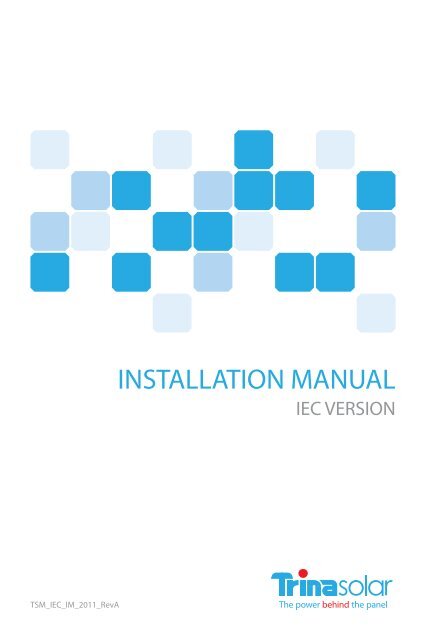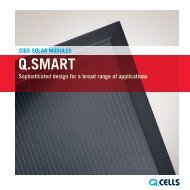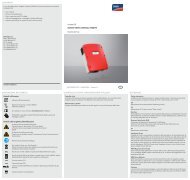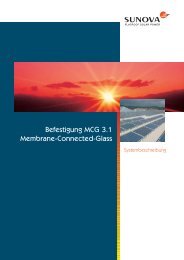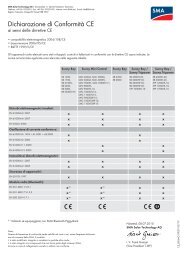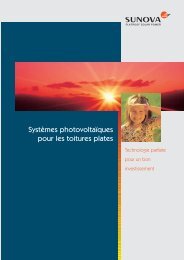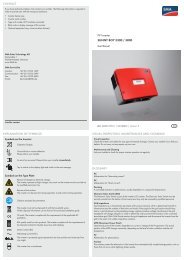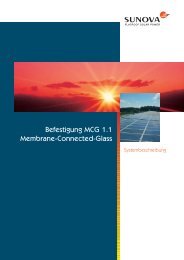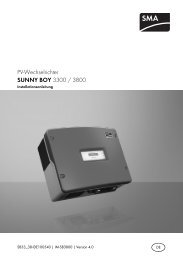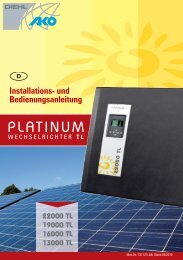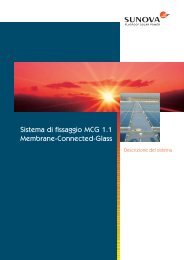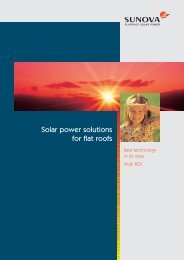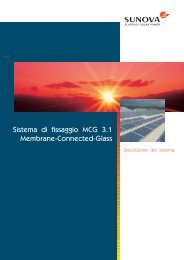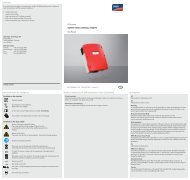Installation instructions - Sunova
Installation instructions - Sunova
Installation instructions - Sunova
You also want an ePaper? Increase the reach of your titles
YUMPU automatically turns print PDFs into web optimized ePapers that Google loves.
TSM_IEC_IM_2011_RevA<br />
INSTALLATION MANUAL<br />
IEC VERSION
INSTALLATION MANUAL<br />
IEC version<br />
1. DISCLAIMER OF LIABILITY<br />
The installation, handling and use of Trina Solar Crystalline series modules are beyond company control. Accordingly,<br />
Trina Solar does not assume responsibility for loss, damage, injury or expense resulting from improper installation,<br />
handling, use or maintenance.<br />
Trina Solar assumes no responsibility for any infringement of patents or other rights of third parties that may result<br />
from use of the module. No license is granted by implication or under any patent or patent rights.<br />
Specifications included in this manual are subject to change without prior notice.<br />
2. SAFETY PRECAUTIONS<br />
• Solar photovoltaic (SPV) modules generate electricity when exposed to light. An array of many modules can cause<br />
lethal shocks and/or burn hazards. Only authorized and trained personnel should have access to the modules.<br />
• Use properly insulated tools and appropriate protective equipment to reduce risk of electric shock.<br />
• Do not stand or step on the module.<br />
• Do not damage or scratch the front or backside surfaces of the module.<br />
• Never use a module with broken glass or torn substrate. Broken modules cannot be repaired and contact with any<br />
module surface or frame can lead to electrical shock.<br />
• Do not disassemble the modules or remove any part of the module.<br />
• Protect plug contacts against soiling; do not make any plug connections using soiled plug contacts.<br />
• Do not install or handle modules when they are wet or during periods of high wind.<br />
• Do not short the positive and the negative of a single SPV module.<br />
• Do not disconnect under load.<br />
• Make sure connectors have no gap between insulators. A gap can cause fire hazard and/or danger of an electrical<br />
shock.<br />
• Make sure that the polarity of each module or a string is not reversed considering the rest of the modules or strings<br />
• Artificially concentrated sunlight should not be used on the SPV module.<br />
• Maximum system voltage must not exceed 1000V DC.<br />
• Under normal conditions, a SPV module is likely to produce more current and /or voltage than reported under<br />
standard test conditions. Accordingly, the value of Isc marked on this module should be multiplied by a factor of 1.25<br />
when determining the conductor current ratings, fuse sizes and size of controls connected to the SPV output.<br />
3. UNPACKING AND STORAGE<br />
• Before installation, keep all modules and electrical contacts clean and dry.<br />
• If it is necessary to store modules temporarily, a dry, ventilated room should be used.<br />
• When unpacking, carry modules with both hands. Do not place modules on top of each other.<br />
4. PRODUCT IDENTIFICATION<br />
We recommend that you take note of the serial number, each individual module has a unique serial number. It is<br />
attached to the backsheet next to the product sticker.<br />
5. ENVIRONMENTAL CONDITIONS AND SITE SELECTION<br />
5.1 CLIMATE CONDITION<br />
Install Trina Solar Crystalline series modules in the following conditions:<br />
Ambient Temperature:<br />
-40°C to +40°C<br />
Operating Temperature:<br />
-40°C to +85°C<br />
Storage Temperature:<br />
-20°C to +40°C<br />
Humidity:<br />
below 85RH%<br />
Mechanical Load Pressure: below 112.78lb / ft2 (5400Pa) *<br />
*<br />
Note: Mechanical load bearing (including wind and<br />
snow loads) of each module is based on mounting<br />
methods. Professional system installers must be<br />
responsible for calculating mechanical loads according<br />
to system design.<br />
The modules have been designed according to IEC61215<br />
edition 2 and IEC61730 standards.<br />
5.2 SITE SELECTION<br />
• In most applications, Trina Solar SPV modules should be installed in a location where they will receive maximum<br />
sunlight throughout the year.<br />
• Modules should be free from shaded at any time of the day because of buildings, trees, chimney, etc.<br />
• Do not install SPV modules in environments subject to corrosion, such as costal areas, or areas with high levels of<br />
sulfur, etc.<br />
2
INSTALLATION MANUAL<br />
IEC version<br />
• Do not install SPV modules in a location where it would be immersed in water or continually exposed to water<br />
from a sprinkler or fountain, etc.<br />
• For roof installations, modules should be mounted over a fire resistant covering, with adequate ventilation<br />
between the module backsheet and the mounting surface.<br />
5.3 MODULE TILT ANGLE<br />
Trina Solar SPV modules connected in series should be installed at the same orientation and angle. Differing<br />
orientations or angles may cause a loss of power output due to differing amounts of sunlight exposure for each<br />
module.<br />
Typically, the optimal tilt for a SPV module is roughly the same as the latitude of installation location.<br />
6. MOUNTING INSTRUCTIONS<br />
6.1 MOUNTING METHODS<br />
SPV modules can be mounted to the substructure<br />
using two methods:<br />
(1) Screw fitting: Using corrosion-proof screws (M8) in<br />
the existing installing holes in the module frame.<br />
• The frame of each module has 4 mounting holes<br />
used to secure the modules to supporting structure.<br />
• The module frame must be attached to a mounting<br />
rail using M8 corrosion-proof screws together with<br />
spring washers and flat washers in four symmetrical<br />
locations on the SPV module.<br />
• Applied torque should be 8 Newton-meters. Please<br />
find detailed mounting information in Figure 1.<br />
Figure1. SPV module installed with screw fitting method *<br />
(2) Clamp fitting: Using suitable module clamps on the side of the module frame to mount the modules (including<br />
“portrait orientation” and “landscape orientation”)<br />
• Use a certain number of clamps to fix modules on the mounting rail.<br />
• Modules clamps should not come into contact with the front glass and must not deform the frame.<br />
• Be sure to avoid shadowing effects from the module clamps.<br />
• The module frame is not to be modified under any circumstances.<br />
• When choosing this type of clamp-mounting method, please be sure to use at least four clamps on each<br />
module, two clamps should be attached on the long sides of the module (for portrait orientation) and short sides<br />
of the module (for landscape orientation). Depending on local wind and snow loads, additional clamps may be<br />
required to ensure modules can bear the load.<br />
• Applied torque should be 8 Newton-meters. Please find detailed mounting information in Figure 2.<br />
Fringe modules installation<br />
Middle modules installation<br />
Figure2. SPV module installed with clamp fitting method *<br />
* Note:<br />
• Clearance between modules frames and surface of the wall or roof is required to prevent wiring damage and to<br />
allow air to circulate behind the module. Recommended stand-off height is 115mm.<br />
• When mounting, be sure that the module's drain holes are not blocked.<br />
We recommend installing modules in landscape and/or portrait orientation. Please refer to the following diagrams<br />
(Figure 3 & 4 ).<br />
3
INSTALLATION MANUAL<br />
IEC version<br />
(1) Landscape orientation installation<br />
1/20 Module Width<br />
1/5 Module Width<br />
Mounting<br />
Area<br />
1/5 Module Width<br />
1/20 Module Width<br />
Mounting<br />
Area<br />
Figure3. Mechanical dimensions when modules installed in landscape orientation with clamp fitting method<br />
(2) Portrait orientation installation<br />
1/20 Module Width<br />
1/5 Module Width<br />
Mounting<br />
Area<br />
1/5 Module Width<br />
1/20 Module Width<br />
Mounting<br />
Area<br />
Figure4. Mechanical dimensions when modules installed in portrait orientation with clamp fitting method<br />
6.2 GROUNDING<br />
• All module frames and mounting racks must be properly grounded in accordance with respective national<br />
electrical code.<br />
• Proper grounding is achieved by bonding the module frame(s) and all metallic structural members together<br />
continuously using a suitable grounding conductor. The grounding conductor or strap may be copper, copper<br />
alloy, or other material acceptable for use as an electrical conductor per respective National Electrical Codes. The<br />
grounding conductor must then make a connection to earth using a suitable earth ground electrode.<br />
• We recommending using the following methods to ground properly:<br />
Method 1: The Ilsco GBL-4DBT Lay-in lug as shown in the following picture:<br />
1<br />
2<br />
3<br />
5<br />
4<br />
6<br />
7<br />
8<br />
1) #8 screw<br />
2) Nut<br />
3) Tooth washer<br />
4) A luminiu m fram e<br />
5) Stainless steel washer<br />
6) La y-in l ug<br />
7) 4-12 AWG cable<br />
8) Stainless steel screw<br />
Figure5. Ilsco GBL-4DBT Lay-in lug<br />
• Secure a grounding lug (e.g. tin-plated copper) with a stainless steel bolt and nut.<br />
• Insert a stainless steel washer (e.g. flat, locking) between the grounding lug and frame.<br />
• Make electrical contact by penetrating the anodized coating of the aluminium frame, usually a stainless steel<br />
toothed washer can be inserted between the nut and the frame to break the anodized layer of frame.<br />
4
INSTALLATION MANUAL<br />
IEC version<br />
6.3 MODULE WIRING<br />
Each module has two 4mm 2 diameter standard 90°C sunlight resistant output cables each terminated with<br />
plug & play connectors. This cable is suitable for applications where wiring is exposed to the direct sunlight. We<br />
recommend that all wiring and electrical connections comply with the appropriate national electrical code.<br />
For field connections, use the minimum 4mm2 diameter copper wires insulated for a minimum of 90°C and<br />
Sunlight resistance as well.<br />
• The minimum and maximum outer diameters of the cable are 5 to 7mm 2 .<br />
7. MAINTENANCE AND CARE<br />
• Under most weather conditions, normal rainfall is sufficient to keep the PV module glass surface clean. If dust or dirt<br />
build-up becomes excessive, clean the glass only with a soft cloth using mild detergent and water.<br />
• Do not clean the modules with cold water during the warmer hours of the day in order to avoid creating any thermal<br />
shock that may damage the module.<br />
• Be cautious when cleaning the back surface of the module to avoid penetrating the substrate material. Modules that<br />
are mounted flat (0° tilt angle) should be cleaned more often, as they will not ''self clean'' as effectively as modules<br />
mounted at a 15° tilt or greater.<br />
• At least once a year, it is recommended to check the torque of terminal screws and the general condition of wiring.<br />
Also, check that mounting hardware is properly torqued. Loose connections will result in damage to the array.<br />
• Modules that have been replaced must be of the same type. Do not touch live parts of cables and connectors. Use<br />
appropriate safety equipment (insulated tools, insulating gloves, etc.) when handling modules.<br />
• Cover the front surface of modules by an opaque material when repairing. When exposed to sunlight, modules<br />
generate high voltage and thus dangerous.<br />
Trina Solar SPV modules are equipped with bypass diodes in the junction box. This minimizes module heating and<br />
current losses.<br />
• Do not try to open the junction box to change the diodes even if it malfunctions. This should be done by qualified<br />
personnel only.<br />
• In a system that uses a battery, blocking diodes are typically placed between the battery and the SPV module output<br />
to prevent battery discharge at night.<br />
Trina Solar is a member of the European PV Cycle Association. Through the pre-financed PV Cycle program, Trina Solar<br />
SPV modules will be taken back and treated in an environmentally sustainable manner.<br />
WARNING: For any electrical maintenance, the SPV system must first be shut down. Improper maintenance<br />
can cause lethal electric shock and/or burns.<br />
5
INSTALLATION MANUAL<br />
IEC version<br />
ASIA PACIFIC<br />
CHINA<br />
Headquarters<br />
No. 2 Trina Road, Trina PV Industrial<br />
Park, New District, Changzhou,<br />
Jiangsu, 213031, China<br />
T +86 519 8548 2008<br />
F +86 519 8517 6021<br />
E sales@trinasolar.com<br />
AUSTRALIA<br />
Macquarie House Sydney<br />
Level 13, Office Number 1315<br />
167 Macquarie Street<br />
Sydney, NSW 2000<br />
Australia<br />
T +61 2 8667 3088<br />
F +61 2 8667 3200<br />
E australia@trinasolar.com<br />
CHINA<br />
Rooms 1704-1706,<br />
CCIG International Plaza,<br />
No. 333 North Caoxi Road,<br />
Shanghai 200030<br />
China<br />
T +86 21 6057 5310<br />
F +86 21 6057 5333<br />
E sales@trinasolar.com<br />
EUROPE<br />
GERMANY<br />
Einsteinring 26,<br />
D-85609 Aschheim/München,<br />
Germany<br />
T +49 89 122 8492 50<br />
F +49 89 122 8492 51<br />
E germany@trinasolar.com<br />
CHINA<br />
X-17KL, Oriental Kenzo office building ,<br />
NO.48 Dongzhimenwai Street,<br />
Dongcheng District ,<br />
Beijing 100027,<br />
T +86 10 5817 4080<br />
F +86 10 5817 4020<br />
E sales_china@trinasolar.com<br />
ITALY<br />
Via Santa Maria Valle 3<br />
20123 Milan<br />
Italy<br />
T +39 02 0068 1521<br />
F +39 02 0068 1400<br />
E italy@trinasolar.com<br />
KOREA<br />
Trina Solar Korea Ltd.<br />
B-912, Intellige 2,<br />
24 Jeongja-dong,<br />
Bundang-gu, Seongnam-si,<br />
Gyeonggi-do, 463-841<br />
Korea<br />
T +82 31 782 1588<br />
F +82 31 718 8820<br />
E korea@trinasolar.com<br />
JAPAN<br />
Trina Solar Japan Ltd<br />
World Trade Center Building<br />
33th Floor, 4-1 2-chome<br />
Hamamatsu-cho Minato-ku,<br />
Tokyo 105-6133<br />
Japan<br />
T +81 3 3437 7000<br />
F +81 3 3437 7001<br />
E japan@trinasolar.com<br />
SPAIN<br />
Paseo de la Castellana 141,<br />
8th Floor,<br />
28046 Madrid,<br />
Spain<br />
T +34 91 572 6576<br />
F +34 91 572 6621<br />
E spain@trinasolar.com<br />
SWITZERLAND<br />
European HQ<br />
Trina Solar (Schweiz) AG<br />
Leutschenbachstr. 45,<br />
8050 Zurich,<br />
Switzerland<br />
T +41 43 299 68 00<br />
F +41 43 299 68 10<br />
E europe@trinasolar.com<br />
NORTH AMERICA<br />
U.S.A.<br />
Trina Solar (U.S.), Inc.<br />
100 Century Center, Suite 340,<br />
San Jose CA 95112,<br />
USA<br />
T +1 800 696 7114<br />
F +1 800 696 0166<br />
E usa@trinasolar.com<br />
www.trinasolar.com


